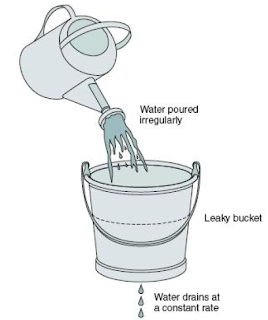* Management of
individual traffic flows & resource allocation to ensure delivery of
QoS(e.g. Delay, jitter, loss)
* Traffic
management at flow level operates on the order of milliseconds to seconds.
* It is
concerned with managing the individual traffic flow to ensure the QoS (e.g.
delay, jitter,
loss) requested by user is satisfied.
* The purpose of
Traffic Management at the Flow Level is to control the flows of traffic and
maintain performance even in presence of traffic overload.
* The process of
managing the traffic flow in order to control congestion is called
congestion
control.
* Congestion occurs
when a surge of traffic overloads network resources
Approaches to
Congestion Control:
• Preventive
Approaches: Scheduling & Reservations
• Reactive
Approaches: Detect & Throttle/Discard
Ideal effect of
congestion control:
Resources used
efficiently up to capacity available
Open-loop control and
closed-loop control are the two logical approaches of congestion control.
Open-Loop Control
* It prevents
congestion from occurring.
* It does not depend on
feedback information to react to congestion.
* Network performance
is guaranteed to all traffic flows that have been admitted into the network
* It depends on three
Key Mechanisms and they are:-
* Admission Control
* Policing
* Traffic Shaping
Admission
Control
* It is a network
function that computes the resource (bandwidth and buffers)
requirements of new
flow and determines whether the resources along the path
to be followed are
available or not available.
* Before sending packet
the source must obtain permission from admission control.
* Admission control
decides whether to accept the flow or not.
* Flow is accepted, if
the QoS of new flow does not violate QoS of existing flows
* QoS can be expressed
in terms of maximum delay, loss probability, delay variance, or other
performance measures.
* QoS requirements:
o Peak, Avg., Min Bit
rate
o Maximum burst size
o Delay, Loss
requirement
* Network computes
resources needed
o “Effective” bandwidth
* If flow accepted,
network allocates resources to ensure QoS delivered as long as
source conforms to
contract
Policing
* Network
monitors traffic flows continuously to ensure they meet their traffic contract.
* The process of
monitoring and enforcing the traffic flow is called policing.
* When a packet
violates the contract, network can discard or tag the packet giving it lower
priority
* If congestion
occurs, tagged packets are discarded first
* Leaky
Bucket Algorithm is the most commonly used policing mechanism
o Bucket has
specified leak rate for average contracted rate
o Bucket has
specified depth to accommodate variations in arrival rate
o Arriving
packet is conforming if it does not result in overflow
Leaky Bucket algorithm
can be used to police arrival rate of a packet stream
Let X = bucket content
at last conforming packet arrival
Let ta be last
conforming packet arrival time = depletion in bucket
Leaky Bucket Algorithm
* The above figure
shows the leaky bucket algorithm that can be used to police the
traffic flow.
* At the arrival of the
first packet, the content of the bucket is set to zero and the last conforming
time (LCT) is set to the arrival time of the first packet.
* The depth of the
bucket is L+I, where l depends on the traffic burstiness.
* At the arrival of the
kth packet, the auxiliary variable X’ records the difference
between the bucket content
at the arrival of the last conforming packet and the
interarrival time
between the last conforming packet and the kth packet.
* If the auxiliary
variable is greater than L, the packet is considered as nonconforming, otherwise
the packet is conforming. The bucket content and the arrival time of the
packet are then
updated. Leaky Bucket Example: - The operation of the leaky bucket algorithm is
illustrated in the below figure.
* Here the value I is
four packet times, and the value of L is 6 packet times.
* The arrival of the
first packet increases the bucket content by four (packet times).
* At the second arrival
the content has decreased to three, but four more are added to the bucket
resulting in total of seven.
* The fifth packet is
declared as nonconforming since it would increase the content to 11, which
would exceed L+I (10).
* Packets 7, 8, 9 and
10 arrive back to back after the bucket becomes empty. Packets 7, 8 and 9 are
conforming, and the last one is nonconforming.
* Non-conforming
packets not allowed into bucket & hence not included in calculations.
Dual Leaky
Bucket
* Dual leaky
bucket is use to police multiple traffic parameters like PCR, SCR, and MBS:
* Traffic is
first checked for SCR at first leaky bucket.
* Nonconforming
packets at first bucket are dropped or tagged.
* Conforming
(untagged) packets from first bucket are then checked for PCR at second bucket.
* Nonconforming packets
at second bucket are dropped or tagged.












0 comments